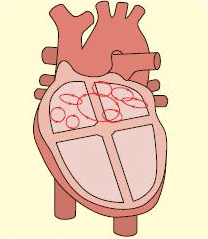Aetiology
Coronary artery disease, hypertension, heart failure, valvular disease, diabetes, thyroid disorders, COPD and obstructive sleep apnoea, and advanced age are among the known risk factors for the development of new-onset AF.[1][6][7] However, AF may occur in the absence of any underlying cardiac or non-cardiac diseases: for example, as a result of heavy alcohol intake.[1][7][8]
Pathophysiology
Pathophysiology of AF involves multiple aetiologies and complex electrophysiological changes for which AF is the final common pathway.[1][6][7][9][10][11] AF is usually associated with anatomically and histologically abnormal atria as a result of underlying heart disease. Dilation of the atria with fibrosis and inflammation causes a difference in refractory periods within the atrial tissue and promotes electrical re-entry that results in AF. The fractionation of a mother wave into multiple wavelets in the presence of enlarged atria in conjunction with the short refractory periods and slow conduction properties of the atria lead to sustained AF. The presence of rapidly firing foci, typically in the pulmonary veins, may trigger AF that is sustained by the first mechanism.[10]
[Figure caption and citation for the preceding image starts]: Multiple wavelets of atrial fibrillation compete with each other in the atrium and bombard the atrioventricular node with many signals.From: Cox D, Dougall H. Student BMJ. 2001;09:399-442 [Citation ends].
AF may also result as degeneration of other rapid arrhythmias, such as atrial tachycardia, atrial flutter, or atrioventricular (AV) nodal re-entrant tachycardia and AV re-entrant tachycardia. The latter occurs in the presence of either concealed or manifest accessory bypass tracts.[7][9][11] Patients with Wolff-Parkinson-White syndrome have a congenital accessory bypass tract that causes arrhythmias.
New-onset AF causes an increase in coronary flow. However, this is not adequate to compensate for the increased myocardial oxygen demand that occurs as a result of irregularity in the ventricular rhythm.[12] Cardiac ischaemia may develop even in patients without coronary artery disease, and this contributes to left ventricular dysfunction and subsequent symptoms of chest discomfort, dizziness and shortness of breath.[12]
Classification
The European Society of Cardiology describes five patterns of AF based on presentation, duration, and spontaneous termination of AF episodes.[1] Acute presentation is limited to:[1]
First diagnosed: not diagnosed before, irrespective of duration of arrhythmia or presence/severity of symptoms
Paroxysmal AF: terminates spontaneously or with intervention within 7 days of onset
Persistent AF: continuously sustained beyond 7 days, including episodes terminated by cardioversion (drugs or electrical cardioversion) after ≥7 days.
A patient may have different types of AF over time: for example, evolving from paroxysmal to persistent.[2]
Use of this content is subject to our disclaimer